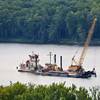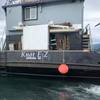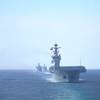Fitzgerald Trains with Nimitz Carrier Strike Group, Japanese
By Mass Communication Specialist 3rd Class Gabriel S. Weber, Fleet Public Affairs Center Japan The crew of the Arleigh Burke-class guided-missile destroyer USS Fitzgerald (DDG 62) participated in the Undersea Warfare Exercise (USWEX) while underway in the Western Pacific.
The exercise, which ended Feb. 22, involved Nimitz Carrier Strike Group (CSG) and elements from the Japan Maritime Self-Defense Force (JMSDF), and focused on training and coordination of anti-submarine warfare (ASW) efforts. "One of the major goals of USWEX was to work with the Nimitz [Carrier] Strike Group, bring them out to the FDNF [Forward-Deployed Naval Forces] area and have them do a real-world exercise with the JMSDF," said Cmdr. Daniel Dusek, Fitzgerald's commanding officer. "As part of the routine training continuum, we're continuing to hone our skills in ASW and work with the Japanese. It was a huge success being able to do that integration."
During the exercise, Fitzgerald Sailors were tasked with locating, tracking and completing simulated engagements with allied submarines in the vicinity of the strike group. Working with the JMSDF and Nimitz CSG provided unique opportunities for all involved to learn from one another, according to Sonar Technician (Surface) 1st Class (SW/IUSS) Joshua Ellsworth.
"This was a chance for us to learn how to work together, share tactics and just get everybody on the same page," Ellsworth said. "It was a learning experience for us in some ways. We got to see what they like to do and they got to see what we like to do. It was just nice to see everybody working on one sheet of music and be able to work together successfully." Dusek said that this exercise and others like it help maintain stability in the region.
"When we do an exercise like this with the Japanese, it really cements the bonds between our countries and provides a stable regional force; a stable Asia for future generations," he said. He added that integrating with the Nimitz strike group and JMSDF allowed them to train more effectively. "We train like we fight," Dusek said. "Had this been an exercise with only 7th Fleet ships, it still would have been a great exercise, but integrating U.S. assets that are not normally deployed to our theater adds a [level of] realism and gives those assets a chance to see how we do ASW in FDNF." Fitzgerald is assigned to Destroyer Squadron 15 and is currently operating in the 7th Fleet area of responsibility. Operating in the Western Pacific and Indian Ocean, the U.S. 7th Fleet is the largest of the forward-deployed U.S. fleets, with approximately 50 ships, 120 aircraft and 20,000 Sailors and Marines assigned at any given time.














